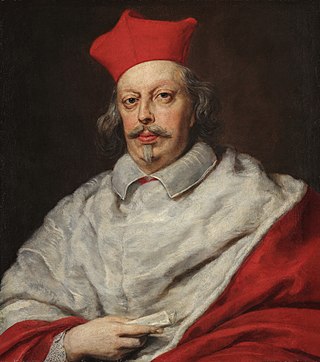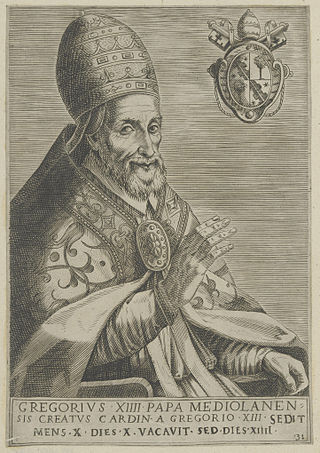This article needs additional citations for verification .(August 2023) |

Francesco Sforza (1562–1624) was an Italian cardinal and bishop. He was very influential in a number of conclaves.
This article needs additional citations for verification .(August 2023) |

Francesco Sforza (1562–1624) was an Italian cardinal and bishop. He was very influential in a number of conclaves.
A member of the House of Sforza, Francesco Sforza was born in Parma on 6 November 1562, the son of Sforza Sforza by his second wife Caterina de' Nobili, a grand-niece of Pope Julius III. He was count of Santa Fiora, marquis of Varci and Castel Acquaro. He was the nephew of Cardinals Guido Ascanio Sforza di Santa Fiora, Roberto de' Nobili, and Alessandro Sforza, and the grand-nephew of Pope Paul III. [1]
He received a military education under Ottavio Farnese, Duke of Parma and later at the court of Francesco I de' Medici, Grand Duke of Tuscany. He also studied Latin, rhetoric, mathematics, philosophy, and politics. He married a sister of Francesco I de' Medici, Grand Duke of Tuscany. At age 18, he served in Flanders under his cousin Alexander Farnese, Duke of Parma; he commanded Italian troops. [1]
Following his wife's death, his half-sister Costanza Sforza, duchess of Sora, who was married to Giacomo Boncompagni, the legitimized son of Pope Gregory XIII, encouraged him to pursue an ecclesiastical career. He became a cleric in Rome and rose quickly in the church, first becoming a canon of the cathedral chapter of San Nicola in Carcere before he had even been ordained as a priest. [1]
Pope Gregory XIII made him a cardinal deacon in the consistory of 12 December 1583. He received the red hat and the deaconry of San Giorgio in Velabro on 6 January 1584, [1] but later exchanged it for Santa Maria in Via Lata. He participated in the papal conclave of 1585 that elected Pope Sixtus V; and in the first papal conclave of 1590 that elected Pope Urban VII. Contemporary newspapers reported that a disagreement between Cardinals Ascanio Colonna and Sforza di Santa Fiora during the conclave nearly became violent. [2]
In the second papal conclave of 1590 he was a member of the Gregorian faction and threw his support to Niccolò Sfondrati, who was elected Pope Gregory XIV. [3] He also participated in the papal conclave of 1591 that elected Pope Innocent IX. In the papal conclave of 1592, Sforza opposed Philip II of Spain's candidate, Giulio Antonio Santorio. Sforza'a brother-in-law and French ally, Ferdinando I de' Medici, Grand Duke of Tuscany secretly engineered the election of Ippolito Aldobrandini as Pope Clement VIII. [4]
From 20 July 1591 until 1597 he was papal legate in Romagna, where he was charged with ridding the province of bandits, which he accomplished. He represented Pope Clement VIII at the baptism of his nephew Cosimo II de' Medici, Grand Duke of Tuscany. He accompanied the pope to Ferrara in 1598. He participated in the first papal conclave of 1605, [5] where he had been angered by Spain's exclusion of Caesar Baronius. The conclave chose Alessandro Ottaviano de' Medici, who had also been excluded after the fact, as Pope Leo XI. He was also present at the second papal conclave of 1605 that elected Pope Paul V. Sforza crowned Pope Paul V in the papal coronation held on 29 May 1605. [1]
He was ordained as a priest in 1614. On 13 November 1617 he opted for the order of cardinal priests and received the titular church of San Matteo in Via Merulana. He became the protopriest of the College of Cardinals. [1]
He opted for the order of cardinal bishop on 5 March 1618, receiving the Suburbicarian Diocese of Albano. He was consecrated as a bishop by Pope Paul V in the apostolic chapel of the Quirinal Palace on 1 May 1618. He opted for the Suburbicarian Diocese of Frascati on 6 April 1620. [1]
He participated in the papal conclave of 1621 that elected Pope Gregory XV and in the papal conclave of 1623 that elected Pope Urban VIII. [1]
On 27 September 1623 he opted for the Suburbicarian Diocese of Porto-Santa Rufina. He was Vice-Dean of the College of Cardinals. [1]
He died in Rome on 9 September 1624. He was buried in San Bernardo alle Terme, the church built by his mother. [6]

Pope Leo XI, born Alessandro Ottaviano de' Medici, was head of the Catholic Church and ruler of the Papal States from 1 April 1605 to his death, on 27 April 1605. His pontificate is one of the briefest in history, having lasted under a month. He was from the prominent House of Medici originating from Florence. Medici's mother opposed his entering the priesthood and sought to prevent it by having him given secular honours, but after her death he eventually was ordained a priest in 1567. In his career he served as Florence's ambassador to the pope, Bishop of Pistoia, Archbishop of Florence, Papal legate to France, and as the cardinal Prefect for the Congregation of Bishops and Regulars. He was elected to the papacy in the March 1605 papal conclave and served as pope for 27 days.

Alessandro Farnese, an Italian cardinal and diplomat and a great collector and patron of the arts, was the grandson of Pope Paul III, and the son of Pier Luigi Farnese, Duke of Parma, who was murdered in 1547. He should not be confused with his nephew, Alessandro Farnese, Governor of the Spanish Netherlands, grandson of Emperor Charles V and great-grandson of Pope Paul III.

Ascanio Maria Sforza Visconti was an Italian cardinal of the Catholic Church. Generally known as a skilled diplomat who played a major role in the election of Rodrigo Borgia as Pope Alexander VI, Sforza served as Vice-Chancellor of the Holy Roman Church from 1492 until 1505.

Carlo de' Medici was an Italian nobleman and Cardinal of the Roman Catholic Church.

The Diocese of Frascati is a Latin suburbicarian see of the Diocese of Rome and a diocese of the Catholic Church in Italy, based at Frascati, near Rome. The bishop of Frascati is a Cardinal Bishop; from the Latin name of the area, the bishop has also been called Bishop of Tusculum. Tusculum was destroyed in 1191. The bishopric moved from Tusculum to Frascati, a nearby town which is first mentioned in the pontificate of Pope Leo IV. Until 1962, the Cardinal-Bishop was concurrently the diocesan bishop of the see. Pope John XXIII removed the Cardinal Bishops from any actual responsibility in their suburbicarian dioceses and made the title purely honorific.

The 1592 papal conclave elected Pope Clement VIII in succession to Pope Innocent IX.

Guido Ascanio Sforza di Santa Fiora was an Italian cardinal, known also as The cardinal of Santa Fiora.

The October to December 1590 papal conclave was the second conclave of 1590, and the one during which Gregory XIV was elected as the successor of Urban VII. This conclave was marked by unprecedented royal interference from Philip II of Spain.

The March–April 1605 papal conclave was convened on the death of Pope Clement VIII and ended with the election of Cardinal Alessandro Ottaviano de' Medici as Pope Leo XI. It was the first of two papal conclaves in 1605; Leo died on 27 April 1605, twenty-six days after he was elected. The conclave was dominated by conflict over whether Cesare Baronius should be elected pope, and Philip III of Spain excluded both Baronius and the eventually successful candidate, Medici.
Bernardino Lunati (1452–1497) was an Italian Roman Catholic cardinal. His entire ecclesiastical career was due to his patron, Cardinal Ascanio Sforza, whom he served first as secretary, then as chancellor. As cardinal, he aided Sforza in his political maneuvers. Sforza was either unable or unwilling to obtain for his protege any munificent benefices and Lunati remained dependent on him.

Antonio Maria Ciocchi del Monte was an Italian Roman Catholic bishop and cardinal.

Fulvio Giulio della Corgna was a Tuscan Catholic bishop and cardinal.

Gianfrancesco Gambara (1533–1587) was an Italian Roman Catholic cardinal and bishop.

Marco Antonio Colonna (1523–1597) was an Italian Roman Catholic bishop and cardinal.

Marcantonio Bobba was an Italian Roman Catholic Bishop of Aosta, Italy and cardinal.

Alessandro Sforza (1534–1581) was an Italian Roman Catholic bishop and cardinal.
Girolamo Rusticucci was an Italian Roman Catholic cardinal and bishop. He was personal secretary to Cardinal Michele Ghislieri, later Pope Pius V, who made Rusticucci a cardinal. He occupied numerous important positions, including papal legate to France and Spain, Camerlengo (treasurer) and Vice-Dean of the College of Cardinals, and Vicar General of Rome.

Pedro de Deza (1520–1600) was a Spanish Roman Catholic cardinal and bishop.
Simeone Tagliavia d'Aragonia (1550–1604) was a Sicilian cardinal and bishop.

The papal conclave of March–April 1605 was convened on the death of Pope Clement VIII and ended with the election of Alessandro Ottaviano de' Medici as Pope Leo XI on 1 April 1605. It was the first of two papal conclaves in 1605, with Leo dying on 27 April 1605, twenty-six days after he was elected, and the conclave to elect his successor being held in May. The conclave saw conflict regarding whether Cesare Baronius should be elected pope, and Philip III of Spain, the Spanish king, excluded both Baronius and the eventually successful candidate, Medici. Philip's exclusion of Medici was announced by Cardinal Ávila after his election to the papacy, and the other cardinals did not view it as valid since Medici had already been elected pope.